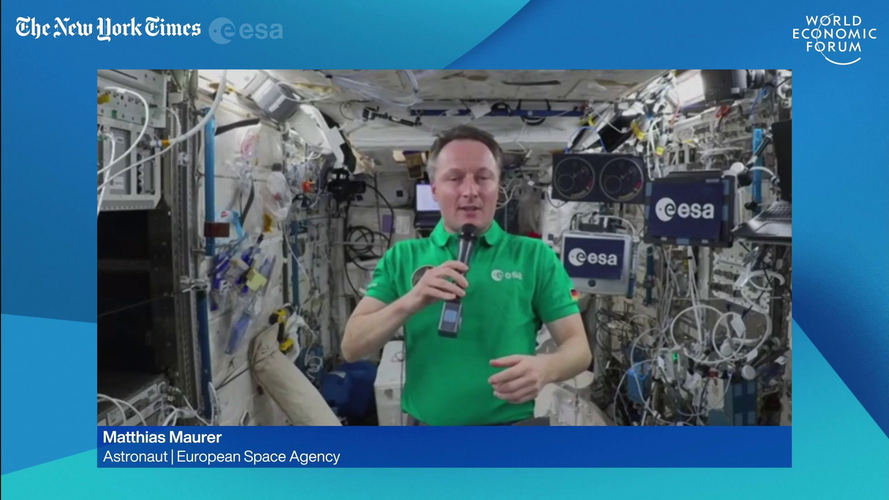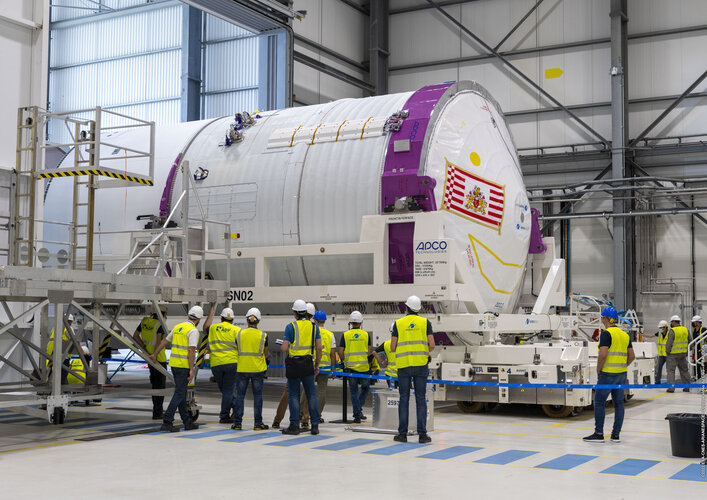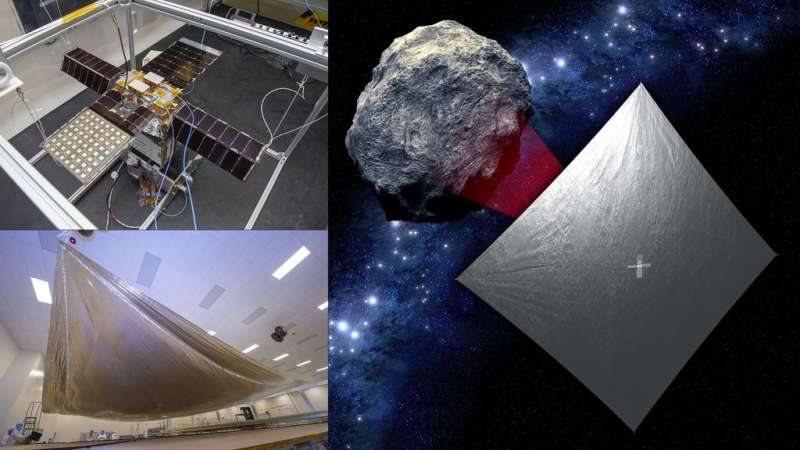
Copernical Team
Friday, 21 January 2022 08:00
ESA/WEF panel discussion and call with Matthias Maurer
 Video:
01:00:30
Video:
01:00:30
Watch the replay of ‘Live from Space: The Next Frontier for Knowledge and Action’. ESA astronaut Matthias Maurer, live from the from the International Space Station discussed with a panel of prominent experts and industry leaders, including ESA’s Director General Josef Aschbacher, about how space research can improve life on our planet.
Published in
News
Tagged under
Friday, 21 January 2022 09:00
Ariane 6 upper stage readies for tests at Europe's Spaceport

The central core of ESA’s new generation Ariane 6 launch vehicle arrived at Europe’s Spaceport on 18 January and is now inside the launch vehicle assembly building.
Published in
News
Tagged under
Friday, 21 January 2022 04:44
The Proba-3 program takes an important step in the integration of its two satellites
Madrid, Spain (SPX) Jan 19, 2022
 The Proba-3 program, spearheaded by SENER Aeroespacial, the project's prime contractor for the European Space Agency (ESA), has accomplished several relevant milestones in the integration of the two satellites that will, for the first time, demonstrate a high- precision formation flight in space.
In the future, spacecraft formation flying technology will be used to replace bulky structures
The Proba-3 program, spearheaded by SENER Aeroespacial, the project's prime contractor for the European Space Agency (ESA), has accomplished several relevant milestones in the integration of the two satellites that will, for the first time, demonstrate a high- precision formation flight in space.
In the future, spacecraft formation flying technology will be used to replace bulky structures
 The Proba-3 program, spearheaded by SENER Aeroespacial, the project's prime contractor for the European Space Agency (ESA), has accomplished several relevant milestones in the integration of the two satellites that will, for the first time, demonstrate a high- precision formation flight in space.
In the future, spacecraft formation flying technology will be used to replace bulky structures
The Proba-3 program, spearheaded by SENER Aeroespacial, the project's prime contractor for the European Space Agency (ESA), has accomplished several relevant milestones in the integration of the two satellites that will, for the first time, demonstrate a high- precision formation flight in space.
In the future, spacecraft formation flying technology will be used to replace bulky structures
Published in
News
Tagged under
Friday, 21 January 2022 04:44
Arianespace to launch Microcarb on Vega C
Evry, France (SPX) Jan 19, 2022
 Arianespace has been awarded a launch contract by ESA, on behalf of the European Commission, to launch Microcarb in 2023 on Vega C. Microcarb is a 190kg satellite developed by CNES that will be delivered into a sun-synchronous orbit, 650km above the Earth.
"We are very proud of this new launch contract, which underlines the capacity of Arianespace to design the most competitive launch solu
Arianespace has been awarded a launch contract by ESA, on behalf of the European Commission, to launch Microcarb in 2023 on Vega C. Microcarb is a 190kg satellite developed by CNES that will be delivered into a sun-synchronous orbit, 650km above the Earth.
"We are very proud of this new launch contract, which underlines the capacity of Arianespace to design the most competitive launch solu
 Arianespace has been awarded a launch contract by ESA, on behalf of the European Commission, to launch Microcarb in 2023 on Vega C. Microcarb is a 190kg satellite developed by CNES that will be delivered into a sun-synchronous orbit, 650km above the Earth.
"We are very proud of this new launch contract, which underlines the capacity of Arianespace to design the most competitive launch solu
Arianespace has been awarded a launch contract by ESA, on behalf of the European Commission, to launch Microcarb in 2023 on Vega C. Microcarb is a 190kg satellite developed by CNES that will be delivered into a sun-synchronous orbit, 650km above the Earth.
"We are very proud of this new launch contract, which underlines the capacity of Arianespace to design the most competitive launch solu
Published in
News
Tagged under
Friday, 21 January 2022 04:44
Perseverance's first year on Mars: Purdue professor, mission team member looks at what is ahead
West Lafayette IN (SPX) Jan 21, 2022
 Almost one year into the Mars rover mission, accomplishing its goal is on the horizon for Purdue University's Briony Horgan and the Perseverance team.
Feb. 18 will mark one year since the rover landed on the red planet following a seven-month, 300-million-mile flight across space.
Horgan, associate professor of planetary science in the Purdue College of Science's Department of Earth,
Almost one year into the Mars rover mission, accomplishing its goal is on the horizon for Purdue University's Briony Horgan and the Perseverance team.
Feb. 18 will mark one year since the rover landed on the red planet following a seven-month, 300-million-mile flight across space.
Horgan, associate professor of planetary science in the Purdue College of Science's Department of Earth,
 Almost one year into the Mars rover mission, accomplishing its goal is on the horizon for Purdue University's Briony Horgan and the Perseverance team.
Feb. 18 will mark one year since the rover landed on the red planet following a seven-month, 300-million-mile flight across space.
Horgan, associate professor of planetary science in the Purdue College of Science's Department of Earth,
Almost one year into the Mars rover mission, accomplishing its goal is on the horizon for Purdue University's Briony Horgan and the Perseverance team.
Feb. 18 will mark one year since the rover landed on the red planet following a seven-month, 300-million-mile flight across space.
Horgan, associate professor of planetary science in the Purdue College of Science's Department of Earth,
Published in
News
Tagged under
Friday, 21 January 2022 04:44
SETI's plan for a sky-monitoring telescope on the moon
Mountain View CA (SPX) Jan 19, 2022
 The SETI Institute teamed up with Louisiana State University (LSU) and Mississippi State University (MSU) to help students design the science program for AstronetX PBC's first lunar-based camera (L-CAM 1). The scientific program planning is funded by a Gordon and Betty Moore Foundation grant to AstronetX. Additional funding for student participation is provided by the National Science Foundation
The SETI Institute teamed up with Louisiana State University (LSU) and Mississippi State University (MSU) to help students design the science program for AstronetX PBC's first lunar-based camera (L-CAM 1). The scientific program planning is funded by a Gordon and Betty Moore Foundation grant to AstronetX. Additional funding for student participation is provided by the National Science Foundation
 The SETI Institute teamed up with Louisiana State University (LSU) and Mississippi State University (MSU) to help students design the science program for AstronetX PBC's first lunar-based camera (L-CAM 1). The scientific program planning is funded by a Gordon and Betty Moore Foundation grant to AstronetX. Additional funding for student participation is provided by the National Science Foundation
The SETI Institute teamed up with Louisiana State University (LSU) and Mississippi State University (MSU) to help students design the science program for AstronetX PBC's first lunar-based camera (L-CAM 1). The scientific program planning is funded by a Gordon and Betty Moore Foundation grant to AstronetX. Additional funding for student participation is provided by the National Science Foundation
Published in
News
Tagged under
Friday, 21 January 2022 04:44
Dust storm grounded Mars helicopter, but it's ready to fly again
Washington DC (UPI) Jan 20, 2021
 One of the Red Planet's famous dust storms has kept the Mars helicopter Ingenuity grounded for two weeks, but the aircraft is scheduled for its 19th flight as early as Sunday, according to NASA.
Around the first of the year, NASA planned Flight 19 of the tiny, 4-pound helicopter on Jan. 5. But weather forecasters on Ingenuity's team in California noticed signs of the approaching dust st
One of the Red Planet's famous dust storms has kept the Mars helicopter Ingenuity grounded for two weeks, but the aircraft is scheduled for its 19th flight as early as Sunday, according to NASA.
Around the first of the year, NASA planned Flight 19 of the tiny, 4-pound helicopter on Jan. 5. But weather forecasters on Ingenuity's team in California noticed signs of the approaching dust st
 One of the Red Planet's famous dust storms has kept the Mars helicopter Ingenuity grounded for two weeks, but the aircraft is scheduled for its 19th flight as early as Sunday, according to NASA.
Around the first of the year, NASA planned Flight 19 of the tiny, 4-pound helicopter on Jan. 5. But weather forecasters on Ingenuity's team in California noticed signs of the approaching dust st
One of the Red Planet's famous dust storms has kept the Mars helicopter Ingenuity grounded for two weeks, but the aircraft is scheduled for its 19th flight as early as Sunday, according to NASA.
Around the first of the year, NASA planned Flight 19 of the tiny, 4-pound helicopter on Jan. 5. But weather forecasters on Ingenuity's team in California noticed signs of the approaching dust st
Published in
News
Tagged under
Friday, 21 January 2022 04:44
NASA prepares final rocket tests for first Artemis moon mission launch
Orlando FL (UPI) Jan 21, 2022
 NASA is preparing the huge Space Launch System moon rocket for final tests on a Kennedy Space Center launchpad in February that would clear the way for a moon launch as early as late March.
The 322-foot-tall SLS rocket for the Artemis I mission is the largest since the last Saturn V rocket rolled out to a launch pad in 1972.
The first lunar mission in decades will help NASA understan
NASA is preparing the huge Space Launch System moon rocket for final tests on a Kennedy Space Center launchpad in February that would clear the way for a moon launch as early as late March.
The 322-foot-tall SLS rocket for the Artemis I mission is the largest since the last Saturn V rocket rolled out to a launch pad in 1972.
The first lunar mission in decades will help NASA understan
 NASA is preparing the huge Space Launch System moon rocket for final tests on a Kennedy Space Center launchpad in February that would clear the way for a moon launch as early as late March.
The 322-foot-tall SLS rocket for the Artemis I mission is the largest since the last Saturn V rocket rolled out to a launch pad in 1972.
The first lunar mission in decades will help NASA understan
NASA is preparing the huge Space Launch System moon rocket for final tests on a Kennedy Space Center launchpad in February that would clear the way for a moon launch as early as late March.
The 322-foot-tall SLS rocket for the Artemis I mission is the largest since the last Saturn V rocket rolled out to a launch pad in 1972.
The first lunar mission in decades will help NASA understan
Published in
News
Tagged under
Friday, 21 January 2022 04:44
NASA Offers $1 Million for Innovative Systems to Feed Tomorrow's Astronauts
Washington DC (SPX) Jan 21, 2022
 As NASA prepares to send astronauts further into the cosmos than ever before, the agency aims to upgrade production of a critical fuel source: food. Giving future explorers the technology to produce nutritious, tasty, and satisfying meals on long-duration space missions will give them the energy required to uncover the great unknown.
In coordination with the Canadian Space Agency, NASA is
As NASA prepares to send astronauts further into the cosmos than ever before, the agency aims to upgrade production of a critical fuel source: food. Giving future explorers the technology to produce nutritious, tasty, and satisfying meals on long-duration space missions will give them the energy required to uncover the great unknown.
In coordination with the Canadian Space Agency, NASA is
 As NASA prepares to send astronauts further into the cosmos than ever before, the agency aims to upgrade production of a critical fuel source: food. Giving future explorers the technology to produce nutritious, tasty, and satisfying meals on long-duration space missions will give them the energy required to uncover the great unknown.
In coordination with the Canadian Space Agency, NASA is
As NASA prepares to send astronauts further into the cosmos than ever before, the agency aims to upgrade production of a critical fuel source: food. Giving future explorers the technology to produce nutritious, tasty, and satisfying meals on long-duration space missions will give them the energy required to uncover the great unknown.
In coordination with the Canadian Space Agency, NASA is
Published in
News
Tagged under
Thursday, 20 January 2022 20:27
NASA solar sail mission to chase tiny asteroid after Artemis I launch

Launching with the Artemis I uncrewed test flight, NASA's shoebox-size Near-Earth Asteroid Scout will chase down what will become the smallest asteroid ever to be visited by a spacecraft.
Published in
News
Tagged under

